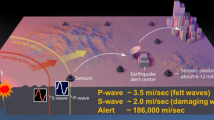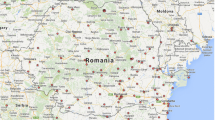Abstract
The foreseeable future of Earthquake Early Warning Systems (EEWS) is their use as a tool for real-time seismic risk management and mitigation. The applicability potential of EEWS seems to be more related to the immediate activation of safety measures for critical systems rather than as a massive alert to the public. Evacuation of buildings requires warning times which are unlikely to be available in many urbanized areas threatened by seismic hazard, whereas the protection of critical systems may still significantly help to reduce the losses subsequent to a catastrophic event and to increase the resiliency of communities to earthquakes.
Real-Time Seismology (RTS), which consists of methods and procedures for the rapid estimation of earthquake and ensuing ground motion features based on measurements made on the first few seconds of the P-waves, is the focus of a great deal of research. In principle, it may boost the potential of regional seismic sensor networks for site-specific applications, in other words: hybrid EEW. Thus the next challenge of early warning and earthquake engineering is geographically distributed seismic networks for the protection of several critical systems and lifelines at the same time. The key issue is related to uncertainty in the estimation of the event’s features. Therefore, the performance target and feasibility factor of such an EEWS is no longer only to maximize the warning time but also calibrate, in a full probabilistic approach, the alarm thresholds and the decisional rules in order to maximize loss reduction following the decision. This paper reviews and discusses some issues raised for hybrid EEWS in the light of performance-based earthquake engineering (PBEE) for risk reduction applications.
Access this chapter
Tax calculation will be finalised at checkout
Purchases are for personal use only
Preview
Unable to display preview. Download preview PDF.
Similar content being viewed by others
References
Allen RM, Kanamori H (2003) The Potential for Earthquake Early Warning in Southern California. Science 300:786–789
Goltz JD (2002) Introducing Earthquake Early Warning in California: A Summary of Social Science and Public Policy Issues, A Report to OES and the Operational Areas. California Governor’s Office for Emergency Services
Grasso VF, Iervolino I, Occhiuzzi A, Manfredi G (2005) Critical Issues of Early Warning Systems for Active Structural Control, ICOSSAR05, 9th Conference on Structural Safety and Reliability, Rome, Italy
Heaton TH (1985) A model for a seismic computerized alert network. Science 228:987–90
Iervolino I, Convertito V, Giorgio M, Manfredi G, Zollo A (2007) The crywolf issue in earthquake early warning applications for the Campania region. In: Gasparini P, Manfredi G, Zschau J (eds) Earthquake Early Warning Systems. Springer
Iervolino I, Giorgio M, Manfredi G (2006) Expected Loss-Based Alarm Threshold Set for Earthquake Early Warning Systems. Submitted for publication
Kanamori H (2005) Real-time seismology and earthquake damage mitigation. Annual Review of Earth and Planetary Sciences 33:5.1–5.20
PEER 2004/05 (2004) Performance-Based Seismic Design Concepts and Implementation Proceedings of the International Workshop Bled, Slovenia, June 28–July 1 2004. Fajfar P, Krawinkler H (eds) Pacific Earthquake Engineering Research Center, Richmond, CA, USA
Porter KA, Beck JL, Ching JY, Mitrani-Reiser J, Miyamura M, Kusaka A, Kudo T, Ikkatai K, Hyodo Y (2004) Real-time Loss Estimation for Instrumented Buildings. Technical Report: CaltechEERL:EERL-2004-08. Earthquake Engineering Research Laboratory, Pasadena, CA
Satriano C, Lomax A, Zollo A (2007) Optimal, real-time earthquake location for early warning. In: Gasparini P, Manfredi G, Zschau J (eds) Earthquake Early Warning Systems. Springer
Veneziano D, Papadimitriou AG (1998) Optimization of the Seismic Early Warning System for the Tohoku Shinkansen. 11th European Conference on Earthquake Engineering. Paris, France
Wald DJ, Quitoriano V, Heaton TH, Kanamori H, Scrivner CW, Orden BC (1999) TriNet “ShakeMaps”: Rapid Generation of Peak Ground Motion and Intensity Maps for Earthquake in Southern California. Earthquake Spectra 15:537–555
Wieland M (2001) Earthquake Alarm, Rapid Response, and Early Warning Systems: Low Cost Systems for Seismic Risk Reduction. Electrowatt Engineering Ltd. Zurich, Switzerland
Wieland M, Griesser M, Kuendig C (2000) Seismic Early Warning System for a Nuclear Power Plant. 12th World Conference on Earthquake Engineering. Auckland, New Zealand
Author information
Authors and Affiliations
Editor information
Editors and Affiliations
Rights and permissions
Copyright information
© 2007 Springer-Verlag Berlin Heidelberg
About this chapter
Cite this chapter
Iervolino, I., Manfredi, G., Cosenza, E. (2007). Earthquake Early Warning and Engineering Application Prospects. In: Gasparini, P., Manfredi, G., Zschau, J. (eds) Earthquake Early Warning Systems. Springer, Berlin, Heidelberg. https://doi.org/10.1007/978-3-540-72241-0_12
Download citation
DOI: https://doi.org/10.1007/978-3-540-72241-0_12
Publisher Name: Springer, Berlin, Heidelberg
Print ISBN: 978-3-540-72240-3
Online ISBN: 978-3-540-72241-0
eBook Packages: Earth and Environmental ScienceEarth and Environmental Science (R0)




